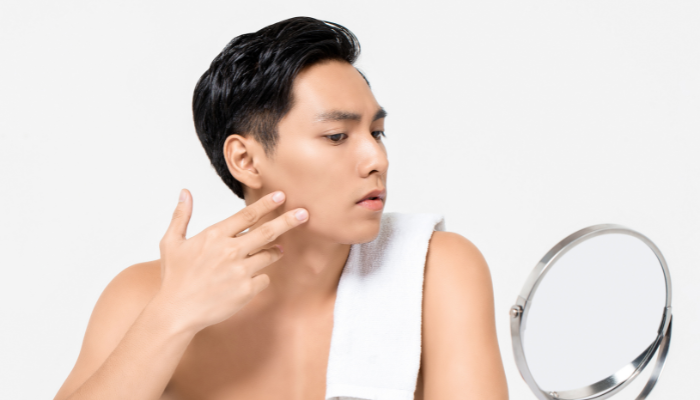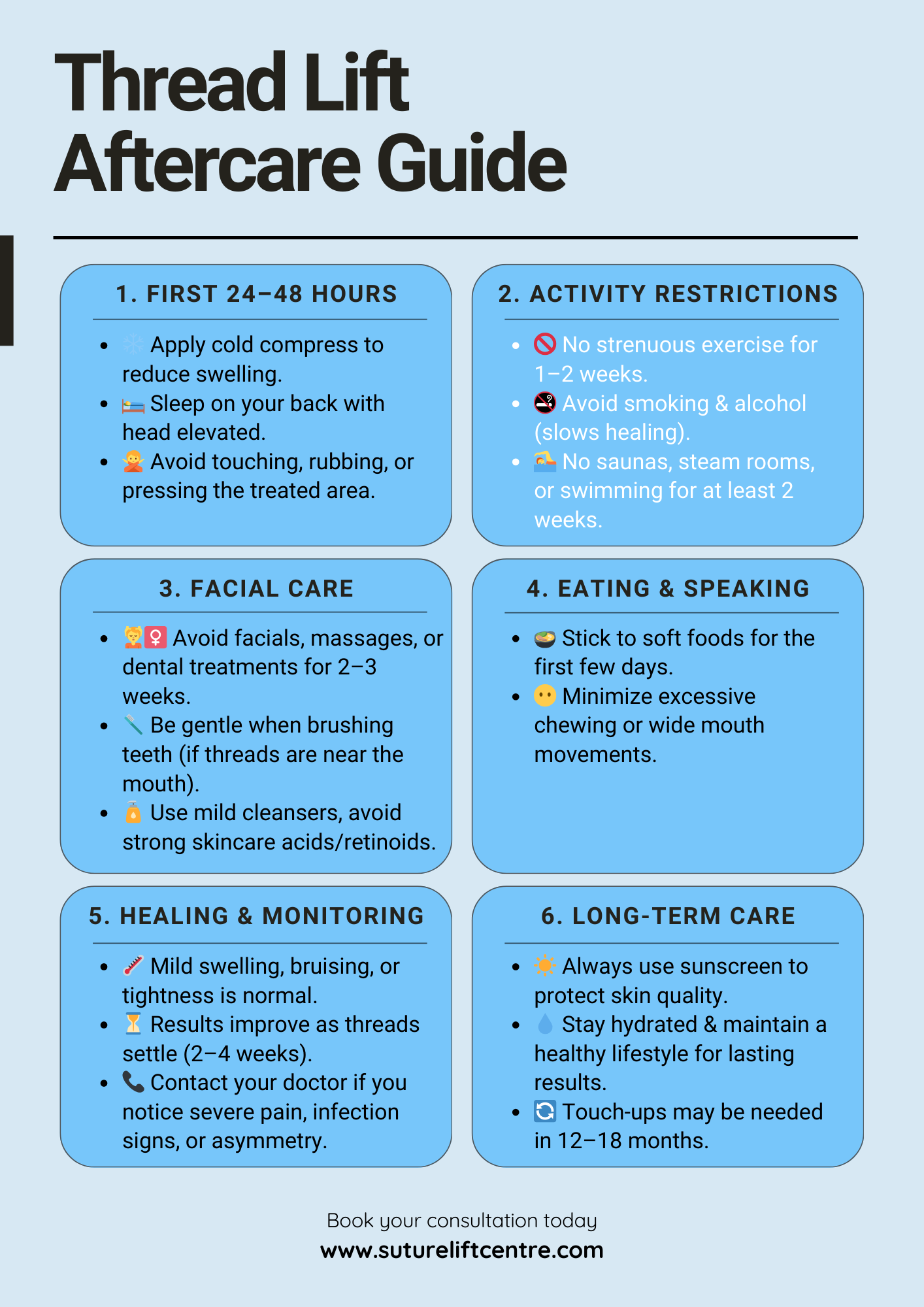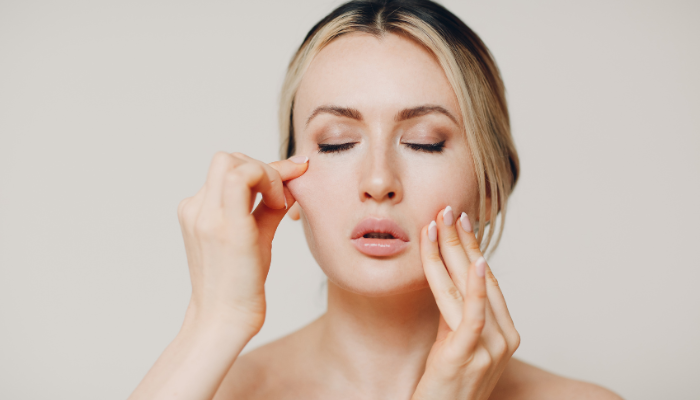So, you’ve had a thread lift, and now it’s been about three months. You’re probably wondering, “Is this it?” or “Am I doing everything right?” It’s totally normal to have questions at this stage. The first few weeks after a thread lift are all about initial healing, but the three-month mark is when things really start to settle and show their true colours.
This guide will walk you through what to expect with your Thread Lift After 3 Months, from how your skin is changing to simple steps you can take to keep that refreshed look going strong. We’ll cover everything you need to know to feel confident about your results.
Key Takeaways
- At three months, your thread lift results should be more settled and natural-looking as swelling goes down and collagen builds.
- Support your results by sticking to a good skincare routine and making healthy lifestyle choices.
- Any lingering swelling or odd sensations should be minor by now; if not, speak to your practitioner.
- Gentle aftercare, like careful cleansing and sun protection, helps keep your skin looking its best.
- Think about future maintenance or complementary treatments to keep your results fresh over time.
Understanding Your Thread Lift After Three Months

So, you’ve had your thread lift, and now you’re three months down the line. It’s a good time to check in and see how things are progressing. Let’s have a look at what you can expect at this stage, how it differs from the initial results, and what’s happening under the skin.
The Science Behind Lasting Lift
At three months, the initial swelling has subsided, and the threads have settled. The real magic is the collagen stimulation that’s been happening. Fibroblasts around the threads are producing new collagen, which helps to maintain the lift and improve skin texture.
This process continues over time, contributing to longer-lasting results. The threads themselves will gradually dissolve, but the collagen matrix they’ve created remains, providing support.
Expected Aesthetic Enhancements
By now, you should be seeing a noticeable improvement in facial contours. Sagging should be reduced, and you might notice a more defined jawline or lifted cheeks. The skin should also appear smoother and more radiant due to the collagen boost.
Remember that results vary from person to person, so don’t compare yourself to others. It’s all about subtle, natural-looking improvements.
Distinguishing From Initial Results
In the first few weeks after a thread lift, the results are primarily due to the physical lift provided by the threads themselves. There might also be some swelling contributing to the initial effect.
At three months, the swelling has gone down, and the results are more refined and natural-looking. The lift is now being maintained by the new collagen, rather than just the threads. This means the results are more stable and less likely to change dramatically.
It’s important to have realistic expectations. A thread lift is not a replacement for a surgical facelift, but it can provide a noticeable improvement for those with mild to moderate sagging. The results are subtle and natural, enhancing your existing features rather than drastically altering your appearance.
Optimising Longevity of Your Results
So, you’ve had your thread lift and you’re seeing the initial benefits. Great! But how do you make sure those results stick around for as long as possible? It’s not just about the procedure itself; it’s about what you do afterwards. Think of it as investing in your investment. Let’s look at some ways to keep that youthful look going strong.
Sustaining Collagen Stimulation
One of the cool things about thread lifts is that they encourage your skin to produce more collagen. This is what gives your skin that plump, youthful look. To keep that collagen production going, consider treatments that complement the thread lift.
Microneedling, for example, can further stimulate collagen and elastin. Regular sessions, as advised by your practitioner, can really help maintain the firmness and elasticity of your skin.
Lifestyle Choices for Enduring Beauty
Your daily habits play a massive role in how long your results last. It’s not rocket science, but it’s important.
- Sun Protection: Wear sunscreen every day, even when it’s cloudy. UV rays break down collagen.
- Hydration: Drink plenty of water to keep your skin hydrated and healthy.
- Smoking: If you smoke, now is a really good time to quit. Smoking damages collagen and elastin, undoing all the good work of the thread lift.
Making small changes to your lifestyle can have a big impact on the longevity of your thread lift results. It’s about creating a holistic approach to beauty and well-being.
Professional Skincare Regimens
Don’t underestimate the power of a good skincare routine. Talk to your practitioner about medical-grade skincare products that can support collagen production and maintain skin health.
- Retinoids: These can help boost collagen and improve skin texture.
- Vitamin C serums: These are great for protecting against free radical damage and promoting collagen synthesis.
- Peptides: These can help stimulate collagen production and improve skin firmness.
Here’s a simple table to illustrate the benefits:
| Skincare Ingredient | Benefit |
|---|---|
| Retinoids | Boosts collagen, improves texture |
| Vitamin C | Protects, promotes collagen |
| Peptides | Stimulates collagen, firms skin |
Remember, consistency is key. A regular, well-thought-out skincare routine can make a significant difference in maintaining your results.
Addressing Common Concerns at the Three-Month Mark
At three months post-procedure, the majority of the initial healing should be complete. However, it’s normal to still have some questions or observations about your suture lift results. Let’s address some of the common concerns that patients often bring up around this time.
Managing Residual Swelling or Bruising
While significant swelling and bruising are usually resolved within the first few weeks, some patients may experience subtle, lingering effects. This is typically mild and resolves on its own. If you notice any unusual discolouration or persistent swelling, it’s always best to get in touch with the clinic.
Gentle massage, as directed by your practitioner, can sometimes help to encourage lymphatic drainage and reduce any remaining puffiness.
Understanding Sensation Changes
It’s not uncommon to experience some altered sensation in the treated areas. This might include tingling, numbness, or increased sensitivity. These changes are usually temporary as the nerves are settling.
- Give it time: Nerve recovery can take several weeks or months.
- Avoid extremes: Protect the area from extreme temperatures.
- Be gentle: Avoid harsh rubbing or pressure.
It’s important to remember that everyone’s healing process is unique. If you’re concerned about any sensation changes, don’t hesitate to reach out. We can assess your specific situation and provide reassurance or further guidance.
When to Consult Your Practitioner
While most post-procedure experiences are uneventful, it’s important to know when to seek professional advice. Keep an eye out for:
- Signs of infection: Increased redness, warmth, pain, or discharge.
- Asymmetry: A noticeable difference in the lift or contour on either side of the face.
- Persistent pain: Pain that doesn’t respond to over-the-counter pain relief.
- Visible sutures: Although rare with our permanent suture lift, if you notice any sutures poking through the skin.
If you experience any of these issues, contact the clinic promptly. Early intervention can help to prevent complications and ensure the best possible outcome.
The Role of Aftercare in Long-Term Success

Getting a suture lift is a great first step, but what you do after the procedure is just as important for making sure you get the best possible results. Think of it like planting a tree – you need to nurture it to see it grow strong and tall.
With suture lifts, proper aftercare helps to maintain the lift, encourage collagen production, and keep your skin looking its best for longer. It’s not just about avoiding complications; it’s about investing in the longevity of your rejuvenated appearance.
Gentle Cleansing and Hydration
Straight after your suture lift, your skin will be a little sensitive, so you need to be extra gentle. Use a mild, fragrance-free cleanser to keep the area clean without irritating it. Avoid anything too harsh or abrasive. Hydration is also key.
Drink plenty of water to keep your skin plump and healthy from the inside out. A good, gentle moisturiser will also help to keep the surface hydrated.
Protecting Your Skin from Environmental Factors
Sun protection is always important, but it’s even more so after a suture lift. Your skin will be more vulnerable to sun damage, which can break down collagen and undo some of the benefits of the procedure.
- Apply a broad-spectrum SPF 30 or higher every day, even on cloudy days.
- Wear a hat and sunglasses when you’re out in the sun.
- Try to avoid prolonged sun exposure, especially during peak hours.
Think of your skin as a delicate fabric. The sun, pollution, and harsh weather can all damage it over time. Protecting your skin from these elements will help to keep it looking younger and healthier for longer.
Avoiding Pressure on Treated Areas
For the first few weeks after your suture lift, it’s important to avoid putting too much pressure on the treated areas. This means:
- Sleeping on your back to avoid pressing your face into the pillow.
- Avoiding strenuous activities that could strain your facial muscles.
- Being careful when washing your face or applying makeup.
Basically, treat your face with extra care and gentleness. This will help the sutures settle properly and prevent any unwanted movement or complications.
Future-Proofing Your Rejuvenation
So, you’ve reached the three-month mark after your thread lift – congratulations! It’s a great time to think about how to keep those results looking good for as long as possible. It’s not just about what you’ve already done, but also about planning for the future to maintain that refreshed look.
Considering Complementary Treatments
Think of your thread lift as a fantastic foundation. Now, you might want to consider other treatments to build on those results. For example, while thread lifts address sagging, they don’t restore lost volume.
Dermal fillers could be a good option to add volume to areas like the cheeks or temples, creating a more balanced and youthful appearance.
Laser treatments can also improve skin texture and tone, complementing the lifting effect of the threads. The key is to discuss your options with your practitioner to create a tailored plan that addresses your specific needs and goals.
Planning for Maintenance Sessions
While suture lifts are designed to be permanent, the natural ageing process continues. Maintenance sessions can help to prolong the effects of your initial procedure. These might involve additional threads to provide further lift or other treatments to address new concerns as they arise. It’s a bit like servicing your car – regular check-ups and minor adjustments can keep everything running smoothly for longer. Talk to your practitioner about a suitable maintenance schedule to keep you looking your best.
Embracing the Ageing Process Gracefully
It’s important to have realistic expectations. A thread lift can turn back the clock, but it won’t stop time altogether. The goal is to look like a refreshed version of yourself, not someone else entirely.
Embrace the ageing process gracefully by focusing on overall well-being, including a healthy lifestyle, good skincare, and a positive attitude. Remember, confidence and self-acceptance are just as important as any cosmetic procedure.
Ultimately, future-proofing your rejuvenation is about combining effective treatments with a holistic approach to beauty and wellness. It’s about making informed choices, working with a skilled practitioner, and embracing the journey of ageing with confidence.
Nutritional Support for Enhanced Healing

It’s easy to overlook the role of nutrition in healing, but what you eat can really make a difference to your recovery after a thread lift. Think of it as providing your body with the building blocks it needs to repair and rejuvenate. Let’s explore how you can support your skin from the inside out.
Anti-Inflammatory Diet Benefits
Following an anti-inflammatory diet can help reduce swelling and promote faster healing. This means focusing on foods that are naturally anti-inflammatory and avoiding those that can exacerbate inflammation.
Here are some foods to include:
- Berries: Rich in antioxidants, they help combat inflammation.
- Leafy Greens: Spinach and kale are packed with vitamins and minerals.
- Fatty Fish: Salmon and mackerel provide omega-3 fatty acids, known for their anti-inflammatory properties.
It’s worth noting that processed foods, sugary drinks, and excessive alcohol can hinder the healing process. Try to limit these as much as possible during your recovery.
Hydration for Skin Health
Hydration is absolutely key for skin health and recovery. Water helps transport nutrients to your skin cells and keeps your skin plump and elastic. Aim for at least 8 glasses of water a day, and consider including hydrating foods like cucumber and watermelon in your diet.
Supplements for Collagen Production
Collagen is the protein that gives your skin its structure and elasticity. While your body naturally produces collagen, this production slows down as we age. Certain supplements can help boost collagen synthesis:
- Vitamin C: Essential for collagen production.
- Zinc: Supports wound healing and collagen formation.
- Collagen Peptides: Can be taken as a supplement to provide the building blocks for collagen.
Always consult with your practitioner or a registered dietitian before starting any new supplement regimen to ensure it’s right for you.
Exercise and Activity Guidelines
It’s been three months since your thread lift, and you’re probably itching to get back to your regular exercise routine. That’s great! But it’s important to ease back in carefully to protect your results. Think of it as a phased return – slow and steady wins the race when it comes to longevity.
Resuming Physical Activities Safely
Okay, so you’re ready to get moving again. Start slow. Begin with low-impact activities like walking, gentle yoga, or swimming. These are great because they get your heart rate up without putting too much stress on your face.
Avoid anything that involves a lot of bouncing or jarring movements in the first few weeks. Listen to your body; if something feels off, stop immediately.
Avoiding Strenuous Movements
This is where you need to be a bit cautious. High-intensity workouts, heavy lifting, and contact sports are best avoided for a bit longer. These activities can increase swelling and potentially put strain on the threads, which could compromise your results.
Think about it – you’ve invested in this procedure, so it’s worth taking the time to protect that investment. Give the threads a chance to fully settle and integrate with your tissues.
Listening to Your Body’s Signals
This is probably the most important advice I can give you. Everyone heals at a different pace, so don’t compare yourself to others. If you experience any pain, increased swelling, or discomfort during or after exercise, it’s a sign that you’re pushing yourself too hard.
Rest, ice the area if needed, and don’t hesitate to contact your practitioner if you have any concerns.
Remember, the goal is to gradually reintroduce exercise into your routine without jeopardising your thread lift results. Patience and self-awareness are key. You’ll be back to your full fitness regime before you know it, but in the meantime, listen to your body and take things one step at a time.
Here’s a simple guide to help you:
- Weeks 1-4: Low-impact activities only.
- Weeks 4-8: Gradually introduce moderate-intensity exercises, avoiding direct facial pressure.
- Week 8+: Reassess with your practitioner before resuming high-intensity activities.
Conclusion
So, there you have it. Three months after your thread lift, you should be seeing some pretty good results. Remember, it’s a journey, not a quick fix. Keep up with good skin care, stay hydrated, and try to live a healthy life. If you have any worries or things don’t feel quite right, just get in touch with your clinic.
They are there to help you. Looking after yourself is key to keeping that fresh look going for as long as possible. You’ve made a good choice for yourself, and now it’s about enjoying the benefits.
Frequently Asked Questions
What should my thread lift look like after three months?
At the three-month mark, you should see your thread lift results looking quite settled and natural. The initial swelling and bruising will have gone, and your skin will feel firmer. This is because the threads have helped your body make new collagen, which is a natural protein that keeps your skin strong and elastic.
How can I make my thread lift results last as long as possible?
To help your thread lift results last longer, keep stimulating collagen. This means eating well, staying hydrated, and using good skincare products. Also, try to avoid strong sun and be gentle with your face, especially around the treated areas.
Is it normal to still have swelling or odd feelings after three months?
It’s normal to have a bit of swelling or bruising right after the procedure, but by three months, these should be gone. If you still have any, or if you feel any strange sensations, it’s a good idea to chat with your practitioner. They can check everything is okay.
What kind of food and drinks should I have to help my skin heal?
Eating healthy foods that fight inflammation, drinking plenty of water, and taking supplements that help your body make collagen can all support your skin’s healing and overall health. This helps your thread lift results look even better.
Does aftercare really matter for long-term results?
Yes, aftercare is super important for long-term success. Keep your skin clean and moisturised, protect it from the sun, and try not to put too much pressure on the areas where you had the threads. This helps your skin heal properly and keeps the results looking good.
What other treatments can help my thread lift results?
You can think about other treatments that work well with thread lifts, like certain facials or skin treatments, to boost your results. Also, plan to have maintenance sessions if your practitioner suggests them. It’s all about keeping your skin looking its best as you get older.




